Jing Gu
Klein Model for Hyperbolic Neural Networks
Oct 22, 2024Abstract:Hyperbolic neural networks (HNNs) have been proved effective in modeling complex data structures. However, previous works mainly focused on the Poincar\'e ball model and the hyperboloid model as coordinate representations of the hyperbolic space, often neglecting the Klein model. Despite this, the Klein model offers its distinct advantages thanks to its straight-line geodesics, which facilitates the well-known Einstein midpoint construction, previously leveraged to accompany HNNs in other models. In this work, we introduce a framework for hyperbolic neural networks based on the Klein model. We provide detailed formulation for representing useful operations using the Klein model. We further study the Klein linear layer and prove that the "tangent space construction" of the scalar multiplication and parallel transport are exactly the Einstein scalar multiplication and the Einstein addition, analogous to the M\"obius operations used in the Poincar\'e ball model. We show numerically that the Klein HNN performs on par with the Poincar\'e ball model, providing a third option for HNN that works as a building block for more complicated architectures.
TemporalBench: Benchmarking Fine-grained Temporal Understanding for Multimodal Video Models
Oct 15, 2024



Abstract:Understanding fine-grained temporal dynamics is crucial for multimodal video comprehension and generation. Due to the lack of fine-grained temporal annotations, existing video benchmarks mostly resemble static image benchmarks and are incompetent at evaluating models for temporal understanding. In this paper, we introduce TemporalBench, a new benchmark dedicated to evaluating fine-grained temporal understanding in videos. TemporalBench consists of ~10K video question-answer pairs, derived from ~2K high-quality human annotations detailing the temporal dynamics in video clips. As a result, our benchmark provides a unique testbed for evaluating various temporal understanding and reasoning abilities such as action frequency, motion magnitude, event order, etc. Moreover, it enables evaluations on various tasks like both video question answering and captioning, both short and long video understanding, as well as different models such as multimodal video embedding models and text generation models. Results show that state-of-the-art models like GPT-4o achieve only 38.5% question answering accuracy on TemporalBench, demonstrating a significant gap (~30%) between humans and AI in temporal understanding. Furthermore, we notice a critical pitfall for multi-choice QA where LLMs can detect the subtle changes in negative captions and find a centralized description as a cue for its prediction, where we propose Multiple Binary Accuracy (MBA) to correct such bias. We hope that TemporalBench can foster research on improving models' temporal reasoning capabilities. Both dataset and evaluation code will be made available.
EditRoom: LLM-parameterized Graph Diffusion for Composable 3D Room Layout Editing
Oct 03, 2024
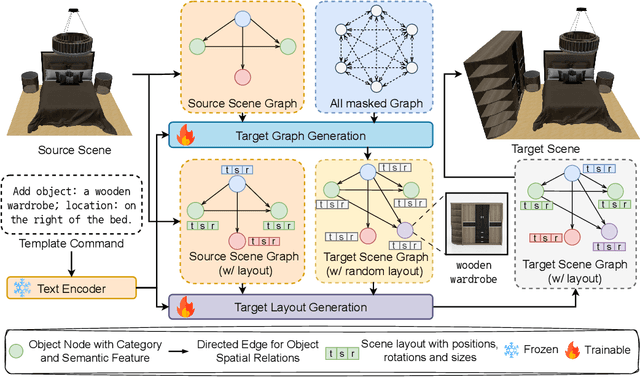

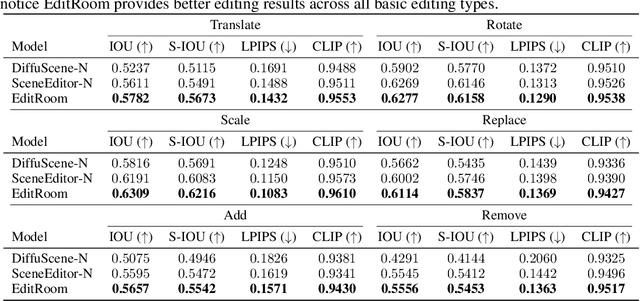
Abstract:Given the steep learning curve of professional 3D software and the time-consuming process of managing large 3D assets, language-guided 3D scene editing has significant potential in fields such as virtual reality, augmented reality, and gaming. However, recent approaches to language-guided 3D scene editing either require manual interventions or focus only on appearance modifications without supporting comprehensive scene layout changes. In response, we propose Edit-Room, a unified framework capable of executing a variety of layout edits through natural language commands, without requiring manual intervention. Specifically, EditRoom leverages Large Language Models (LLMs) for command planning and generates target scenes using a diffusion-based method, enabling six types of edits: rotate, translate, scale, replace, add, and remove. To address the lack of data for language-guided 3D scene editing, we have developed an automatic pipeline to augment existing 3D scene synthesis datasets and introduced EditRoom-DB, a large-scale dataset with 83k editing pairs, for training and evaluation. Our experiments demonstrate that our approach consistently outperforms other baselines across all metrics, indicating higher accuracy and coherence in language-guided scene layout editing.
LLMs Assist NLP Researchers: Critique Paper (Meta-)Reviewing
Jun 25, 2024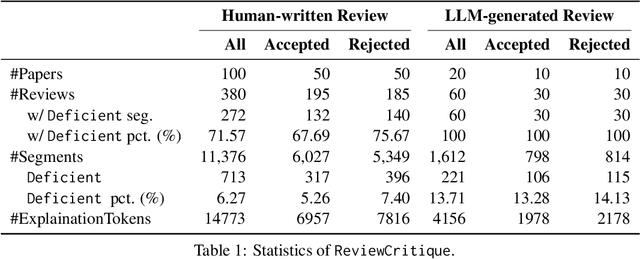
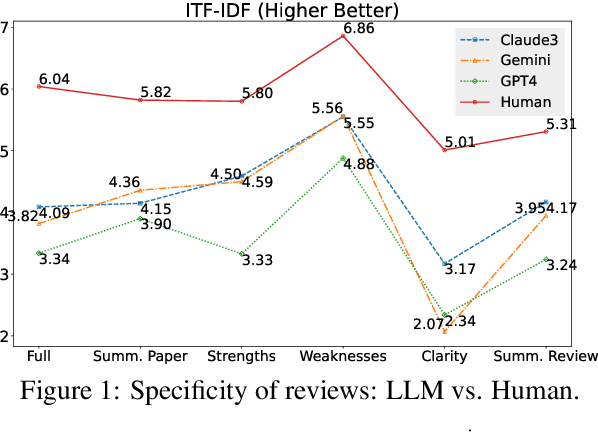
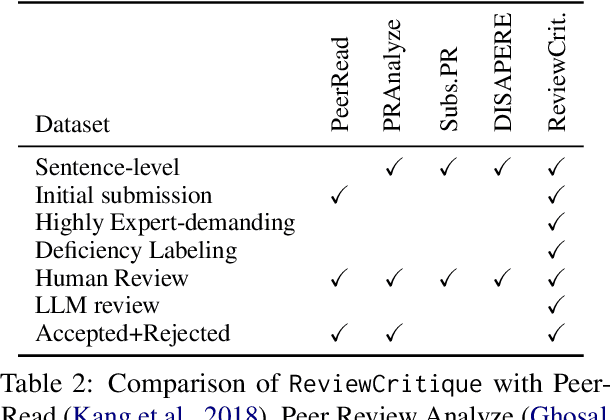
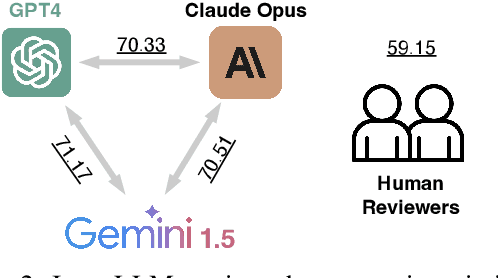
Abstract:This work is motivated by two key trends. On one hand, large language models (LLMs) have shown remarkable versatility in various generative tasks such as writing, drawing, and question answering, significantly reducing the time required for many routine tasks. On the other hand, researchers, whose work is not only time-consuming but also highly expertise-demanding, face increasing challenges as they have to spend more time reading, writing, and reviewing papers. This raises the question: how can LLMs potentially assist researchers in alleviating their heavy workload? This study focuses on the topic of LLMs assist NLP Researchers, particularly examining the effectiveness of LLM in assisting paper (meta-)reviewing and its recognizability. To address this, we constructed the ReviewCritique dataset, which includes two types of information: (i) NLP papers (initial submissions rather than camera-ready) with both human-written and LLM-generated reviews, and (ii) each review comes with "deficiency" labels and corresponding explanations for individual segments, annotated by experts. Using ReviewCritique, this study explores two threads of research questions: (i) "LLMs as Reviewers", how do reviews generated by LLMs compare with those written by humans in terms of quality and distinguishability? (ii) "LLMs as Metareviewers", how effectively can LLMs identify potential issues, such as Deficient or unprofessional review segments, within individual paper reviews? To our knowledge, this is the first work to provide such a comprehensive analysis.
VIA: A Spatiotemporal Video Adaptation Framework for Global and Local Video Editing
Jun 18, 2024



Abstract:Video editing stands as a cornerstone of digital media, from entertainment and education to professional communication. However, previous methods often overlook the necessity of comprehensively understanding both global and local contexts, leading to inaccurate and inconsistency edits in the spatiotemporal dimension, especially for long videos. In this paper, we introduce VIA, a unified spatiotemporal VIdeo Adaptation framework for global and local video editing, pushing the limits of consistently editing minute-long videos. First, to ensure local consistency within individual frames, the foundation of VIA is a novel test-time editing adaptation method, which adapts a pre-trained image editing model for improving consistency between potential editing directions and the text instruction, and adapts masked latent variables for precise local control. Furthermore, to maintain global consistency over the video sequence, we introduce spatiotemporal adaptation that adapts consistent attention variables in key frames and strategically applies them across the whole sequence to realize the editing effects. Extensive experiments demonstrate that, compared to baseline methods, our VIA approach produces edits that are more faithful to the source videos, more coherent in the spatiotemporal context, and more precise in local control. More importantly, we show that VIA can achieve consistent long video editing in minutes, unlocking the potentials for advanced video editing tasks over long video sequences.
The AI Collaborator: Bridging Human-AI Interaction in Educational and Professional Settings
May 16, 2024Abstract:AI Collaborator, powered by OpenAI's GPT-4, is a groundbreaking tool designed for human-AI collaboration research. Its standout feature is the ability for researchers to create customized AI personas for diverse experimental setups using a user-friendly interface. This functionality is essential for simulating various interpersonal dynamics in team settings. AI Collaborator excels in mimicking different team behaviors, enabled by its advanced memory system and a sophisticated personality framework. Researchers can tailor AI personas along a spectrum from dominant to cooperative, enhancing the study of their impact on team processes. The tool's modular design facilitates integration with digital platforms like Slack, making it versatile for various research scenarios. AI Collaborator is thus a crucial resource for exploring human-AI team dynamics more profoundly.
SwapAnything: Enabling Arbitrary Object Swapping in Personalized Visual Editing
Apr 08, 2024
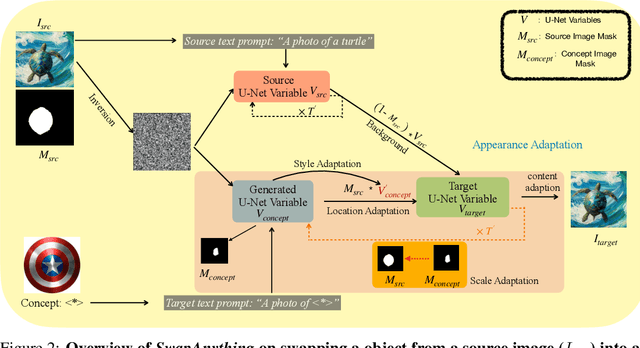
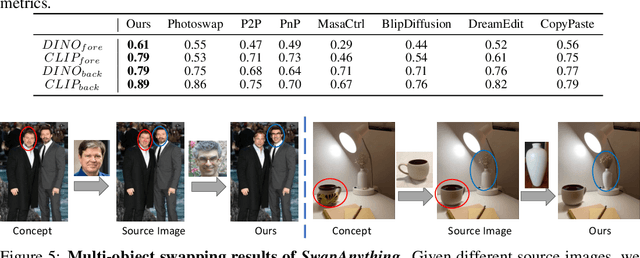

Abstract:Effective editing of personal content holds a pivotal role in enabling individuals to express their creativity, weaving captivating narratives within their visual stories, and elevate the overall quality and impact of their visual content. Therefore, in this work, we introduce SwapAnything, a novel framework that can swap any objects in an image with personalized concepts given by the reference, while keeping the context unchanged. Compared with existing methods for personalized subject swapping, SwapAnything has three unique advantages: (1) precise control of arbitrary objects and parts rather than the main subject, (2) more faithful preservation of context pixels, (3) better adaptation of the personalized concept to the image. First, we propose targeted variable swapping to apply region control over latent feature maps and swap masked variables for faithful context preservation and initial semantic concept swapping. Then, we introduce appearance adaptation, to seamlessly adapt the semantic concept into the original image in terms of target location, shape, style, and content during the image generation process. Extensive results on both human and automatic evaluation demonstrate significant improvements of our approach over baseline methods on personalized swapping. Furthermore, SwapAnything shows its precise and faithful swapping abilities across single object, multiple objects, partial object, and cross-domain swapping tasks. SwapAnything also achieves great performance on text-based swapping and tasks beyond swapping such as object insertion.
Three Revisits to Node-Level Graph Anomaly Detection: Outliers, Message Passing and Hyperbolic Neural Networks
Mar 06, 2024Abstract:Graph anomaly detection plays a vital role for identifying abnormal instances in complex networks. Despite advancements of methodology based on deep learning in recent years, existing benchmarking approaches exhibit limitations that hinder a comprehensive comparison. In this paper, we revisit datasets and approaches for unsupervised node-level graph anomaly detection tasks from three aspects. Firstly, we introduce outlier injection methods that create more diverse and graph-based anomalies in graph datasets. Secondly, we compare methods employing message passing against those without, uncovering the unexpected decline in performance associated with message passing. Thirdly, we explore the use of hyperbolic neural networks, specifying crucial architecture and loss design that contribute to enhanced performance. Through rigorous experiments and evaluations, our study sheds light on general strategies for improving node-level graph anomaly detection methods.
Muffin or Chihuahua? Challenging Large Vision-Language Models with Multipanel VQA
Jan 29, 2024



Abstract:Multipanel images, commonly seen as web screenshots, posters, etc., pervade our daily lives. These images, characterized by their composition of multiple subfigures in distinct layouts, effectively convey information to people. Toward building advanced multimodal AI applications, such as agents that understand complex scenes and navigate through webpages, the skill of multipanel visual reasoning is essential, and a comprehensive evaluation of models in this regard is important. Therefore, our paper introduces Multipanel Visual Question Answering (MultipanelVQA), a novel benchmark that specifically challenges models in comprehending multipanel images. The benchmark comprises 6,600 questions and answers related to multipanel images. While these questions are straightforward for average humans, achieving nearly perfect correctness, they pose significant challenges to the state-of-the-art Large Vision Language Models (LVLMs) we tested. In our study, we utilized synthetically curated multipanel images specifically designed to isolate and evaluate the impact of diverse factors on model performance, revealing the sensitivity of LVLMs to various interferences in multipanel images, such as adjacent subfigures and layout complexity. As a result, MultipanelVQA highlights the need and direction for improving LVLMs' ability to understand complex visual-language contexts. Code and data are released at https://sites.google.com/view/multipanelvqa/home.
Photoswap: Personalized Subject Swapping in Images
May 29, 2023Abstract:In an era where images and visual content dominate our digital landscape, the ability to manipulate and personalize these images has become a necessity. Envision seamlessly substituting a tabby cat lounging on a sunlit window sill in a photograph with your own playful puppy, all while preserving the original charm and composition of the image. We present Photoswap, a novel approach that enables this immersive image editing experience through personalized subject swapping in existing images. Photoswap first learns the visual concept of the subject from reference images and then swaps it into the target image using pre-trained diffusion models in a training-free manner. We establish that a well-conceptualized visual subject can be seamlessly transferred to any image with appropriate self-attention and cross-attention manipulation, maintaining the pose of the swapped subject and the overall coherence of the image. Comprehensive experiments underscore the efficacy and controllability of Photoswap in personalized subject swapping. Furthermore, Photoswap significantly outperforms baseline methods in human ratings across subject swapping, background preservation, and overall quality, revealing its vast application potential, from entertainment to professional editing.
 Add to Chrome
Add to Chrome Add to Firefox
Add to Firefox Add to Edge
Add to Edge